Gerrardstown is an unincorporated community village located along W.Va. Route 51 in Berkeley County in West Virginia's Eastern Panhandle region in the lower Shenandoah Valley.

The Harner Homestead, is a historic home outside Morgantown, Monongalia County, West Virginia.

Cedar Lawn, also known as Berry Hill and Poplar Hill, is one of several houses built near Charles Town, West Virginia for members of the Washington family. Cedar Lawn was built in 1825 for John Thornton Augustine Washington, George Washington's grand-nephew. The property was originally part of the Harewood estate belonging to Samuel Washington. The property that eventually became Cedar Lawn was left to Samuel's son, Thornton Washington, who built "Berry Hill", named for his wife's family. Berry Hill was destroyed by fire, and John Thornton Augustine built Cedar Lawn when he inherited.

Cool Spring Farm — also known as Rockdale Spring Farm and Torytown — was a wilderness estate settled by Colonel Morgan Morgan (1688-1766), long celebrated as the first permanent European settler in what would become West Virginia. The Welsh-born Morgan was granted 1,000 acres (4.0 km2) here in 1735, but he is believed to have first settled there in 1731. Recent research indicates that Morgan's settlement was not the first, but was preceded by a German settlement at what became "New Mecklinberg", possibly as early as 1726.

William Wilson House, also known as Prospect Hill and the Trammell Hollis House, is a historic home located in Gerrardstown, Berkeley County, West Virginia. It was built between 1792 and 1802, and is a large, two story brick dwelling on a stone foundation in a late-Georgian style. It measures 36 feet 6 inches (11.13 m) deep and 70 feet (21 m) wide and consists of a three-bay central block with a four-bay side wing. The interior features a mural by Baltimore artist Olive Verna Rogers painted in 1936. The property includes four brick outbuildings dated as far back as the 1850s: a kitchen, spring house, privy, and the original stone dwelling house.

Campbellton is a house near Gerrardstown, West Virginia built circa 1800 by James Campbell. Campbell, who was born in Ireland in 1744, arrived in America with his father in 1753, settling in Berkeley County, West Virginia in 1762. Campbell built a store on the property in 1780, along with a complex of accessory buildings, before building the main house.
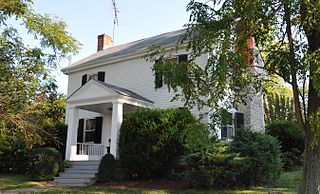
Morgan-Gold House, also known as "Golden Meadows" or the Samuel Gold House, is a historic home located at Bunker Hill, Berkeley County, West Virginia. It is an "L" shaped, three bay, two-story, log dwelling on a stone foundation. The front section was built about 1809, and is a 20 1/2-feet deep and 30 1/2-feet wide block, with a pedimented portico in the Greek Revival style. The rear part of the ell was built about 1745 by David Morgan, son of the Morgan Morgan the first white settler of West Virginia. Also on the property are three log outbuildings and Victorian-era granary.

John, David, and Jacob Rees House, also known as Lefevre Farm, is a historic home located at Bunker Hill, Berkeley County, West Virginia. It is an "L" shaped, log, stone and brick dwelling on a stone foundation. It measures 45 feet wide by 70 feet deep, and was built in three sections, the oldest, three bay log section dating to about 1760. The two story, three bay rubble stone section is in the Federal style and built in 1791. The front section was built about 1855 and is a five bay wide, 2+1⁄2-story building in the Greek Revival style. Also on the property is a small stone spring house and log barn.
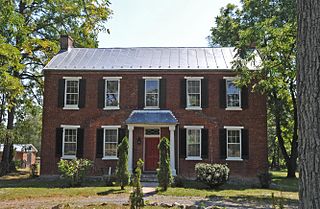
Washington Gold House, also known as "Mountain View" Farm, is a historic home located near Gerrardstown, Berkeley County, West Virginia. It was built in 1854 and is a two-story,"L"-shaped brick dwelling in the Greek Revival style. The house is in two sections; the front section is five bays wide and the rear section four bays deep. The front facade features a Victorian entrance porch added about 1890. Also on the property is a carriage house and small long cabin, known as the Rippey cabin for the original owner.

Hays-Gerrard House is a historic home located at Gerrardstown, Berkeley County, West Virginia. It was built about 1743 and is a two-story, three bay wide limestone dwelling. It measures 16 feet by 27 feet and has a steeply pitched gable roof. The property was the site of the first Baptist church in the area and home to Rev. John Gerrard, first Baptist minister west of the Blue Ridge Mountains. The house was restored in the 1970s.

Mary Park Wilson House, also known as "Old Stone House Farm" and "Oban Hall," is a historic home located near Gerrardstown, Berkeley County, West Virginia. It was built in 1825 by William Wilson for his wife Mary Park Wilson. The Federal style, rubble stone house has two sections: a three bay, two-story central block with a three-bay, two-story wing. The central block measures 52 feet wide by 21 feet deep. The wing features a two-story recessed porch. The property was purchased in 1952, by Archibald McDougall who named it "Oban Hall."

Morris Rees III House, also known as George McKown House and Springvale, is a historic home located near Gerrardstown, Berkeley County, West Virginia. It was built about 1805 and is a two-story, three bay, gable roofed stone house in the Federal style. It sits on a cut stone foundation and features a one-story, one bay portico supported by Tuscan order columns. The portch was built about 1980 and is a replica of the original. Also on the property are a frame kitchen / living quarters, a frame stable, a barn, tractor shed, a stone spring house, a cinder block garage, and a metal grain bin.
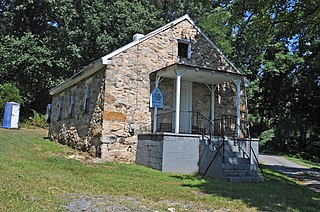
Mt. Pleasant School, now known as Mt. Olive Methodist Church, is a historic one-room school building located near Gerrardstown, Berkeley County, West Virginia. It was built about 1897 and is a one-story, gable roofed vernacular building. It measures approximately 24 feet wide and 39 feet deep. The exterior is finished in native random ashlar limestone. It is built into the slope of the hillside, and features a raised front porch. The school was built for African American children. It ceased use as a school in 1939 and began use as a church in 1942.

Gerrardstown Historic District is a national historic district located at Gerrardstown, Berkeley County, West Virginia. It encompasses 92 contributing buildings, 4 contributing sites, and 2 contributing structures. Notable commercial buildings include the Gerrardstown Corner Store, Wiest Antiques Store, Richard McCormick Store, Charles Crim Store, and David S. Griffith General Store. Most houses are 2 1/2 stories and are representative of a number of popular architectural styles including Queen Anne, Federal, and Greek Revival. Religious properties include the Presbyterian Church (1893) and Cemetery and Southern Methodist Episcopal Church (1883). Also included is the Lutheran Cemetery with burials dating to 1818. Located within the district is the separately listed Hays-Gerrard House.
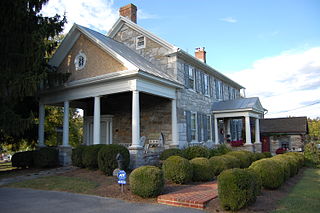
Samuel Cunningham House, also known as Pleasant View Farm, is a historic home located near Hedgesville, Berkeley County, West Virginia. It was built in 1820 and is a two-story, eight bay, gable roofed stone and brick house. The house was expanded about 1840 and a Colonial Revival style porch was added in the early 20th century. Also on the property is a brick smoke house.
Morlunda, also known as the Col. Samuel McClung Place and Oscar Nelson Farm, is a historic home located near Lewisburg, Greenbrier County, West Virginia. It was built in 1827–1828, and consists of a main house with ell. The main house is a two-story brick building measuring 56 feet long and 21 feet deep. The ell measures 48 feet and it connects to a 1+1⁄2-story formerly detached kitchen.
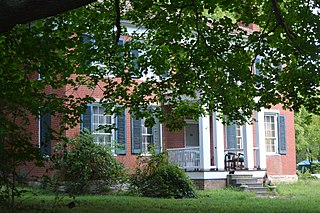
The Governor Samuel Price House, also known as the Preston House, is a historic home located at Lewisburg, Greenbrier County, West Virginia. It was the residence of Samuel Price. It was built in the 1830s, and is a two-story brick dwelling on a cut stone foundation, with a rectangular main section and ell on the western side. It has a hipped roof on the main section and gable roof on the ell. Also on the property are two brick octagonal dependencies; a bath and a smokehouse.
"The Willows", also known as Randolph House, is a historic home located near Moorefield, Hardy County, West Virginia. It was built in three sections in a telescoping style. It consists of One small log house, a middle section of frame, and a brick mansion all connected end-to-end. The oldest section is the 1+1⁄2-story log structure built before 1773. The main section is a two-story, brick Greek Revival style mansion house. It features a square columned entrance porch. During the American Civil War, McNeill's Rangers used the farm for care of some of their horses. In the last year of the War, McNeill's Rangers commander Major Harry Gilmore used "The Willows" as his command.

The Downtown Morgantown Historic District is a federally designated historic district in Morgantown, Monongalia County, West Virginia. The district, encompassing approximately 75 acres, has 122 contributing buildings and 2 contributing sites including commercial and public buildings, residences, and churches. The district has been listed on the National Register of Historic Places since May 2, 1996. Ten of the contributing buildings are listed separately on the National Register of Historic Places. Significant structures located within the historic district are the Monongalia County Courthouse, the Metropolitan Theater, and the Old Morgantown Post Office.

James Clark McGrew House, also known as the Gibson Property, is a historic home located at Kingwood, Preston County, West Virginia. The house consists of a large main two-story block and a low two-story ell. The oldest section is the northern ell, built in 1841. The main block was built about 1870. Also on the property are a contributing two-story barn/outbuilding connected to the house with a breezeway and a two-story Gothic Revival barn/carriage house. The house was built by James McGrew, a founding father of West Virginia.




















